|
Lewis & Clark
Author: Cédrick Chaboussit
Publisher: Ludonaute
Year: 2013
review by

| x |
|
|
|
|
|
|
|
|
|
|
|
|
|
|
|
|
|
|
|
|
|
|
|
|
|
|
|
|
|
|
|
|
|
|
|
|
|
|
|
|
|
|
|
|
|
|
|
|
|
|
|
|
|
|
|
|
|
|
|
|
|
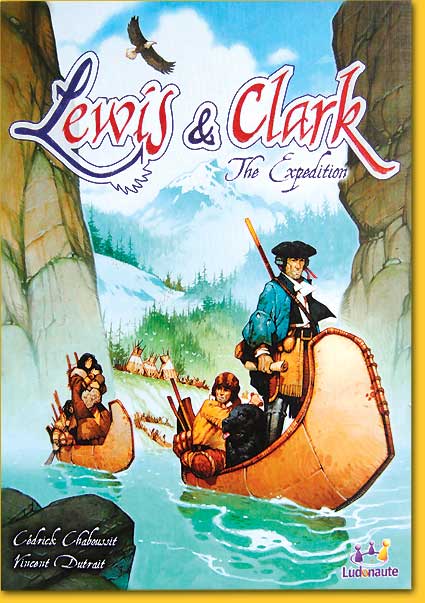 |
A frequently heard comment regarding board games is that the theme is pasted on. This doesn't necessarily need to be a problem, although it is easier for players to commit themselves to a game with a fitting theme; the mechanisms are more logical and therefore easier and quicker to understand and adept. As for the theme, concerned players in 'Lewis & Clark' don't have anything to complain; the game has a historical background: the exploratory expedition from 1803 to 1805 by order of U.S. President Thomas Jefferson after Louisiana was acquired for $ 15 million from the French emperor Napoleon. The expedition headed West to ultimately reach the West coast, mapping the terrain all along the way.
Two to four players do the same and each start their own expedition in a race who will be the first to reach the West coast and set up his camp there. They will do this by making use of character cards that supply raw materials or other advantages, and use the knowledge of the Indians along the way. |
|
|
|
|
| x |
|
|
|
|
|
|
|
|
|
|
|
|
|
|
|
|
|
|
|
|
|
|
|
|
|
|
|
|
|
|
|
|
|
|
|
|
|
|
|
|
|
|
|
|
|
|
|
|
|
|
|
|
|
|
|
|
|
|
|
|
|
|
Apparently the expedition mostly went over water; this at least is the trail that has to be taken from St. Louis. Somewhere further down the river the route is hampered by mountainous terrain, but this is a concern to be done later. Each player starts the game with his own, but identical to the other players, set of six character cards. The historically interested player can read in the rules which persons are in his expedition where the author has put effort in trying to match the function of the card with the character depicted. For example, 'François Labiche' is an experienced boatsman and trader who speaks several Indain languages; the card function therefore has to do with Indians. And what to think of 'Hugh Hall'? He was one of the lumberjacks in the expedition with a penchant for whiskey, which together with other army infractions resulted in court martial penalties that however were not of sufficient severity to dismiss him from the party. Nice to know, eh?
|
|
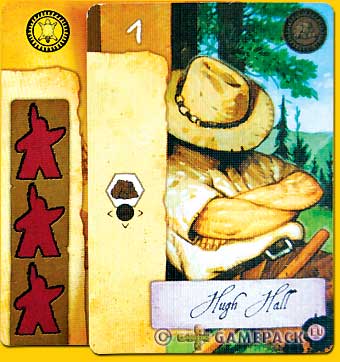 |
|
|
|
| x |
|
|
|
|
|
|
|
|
|
|
|
|
|
|
|
|
|
|
|
|
|
|
|
|
|
|
|
|
|
|
|
|
|
|
|
|
|
|
|
|
|
|
|
|
|
|
|
|
|
|
|
|
|
|
|
|
|
|
|
|
|
 |
|
Wood, fur, food and equipment are placed on the board, together with the canoes, horses and a single Indian. A row of five new character cards are on display along the side of the board; these can be bought against changing costs and put on the hand. All players start with their scouts in St. Louis, and also place their camp marker there. |
|
|
|
|
| x |
|
|
|
|
|
|
|
|
|
|
|
|
|
|
|
|
|
|
|
|
|
|
|
|
|
|
|
|
|
|
|
|
|
|
|
|
|
|
|
|
|
|
|
|
|
|
|
|
|
|
|
|
|
|
|
|
|
|
|
|
|
| Each player also has his own player board depicting three boats for the expedition members, and two spots for the accompanying Indians. Moreover, each player starts off with some equipment, fur and food, and an Indian that he places on his board. |
|
|
|
|
| x |
|
|
|
|
|
|
|
|
|
|
|
|
|
|
|
|
|
|
|
|
|
|
|
|
|
|
|
|
|
|
|
|
|
|
|
|
|
|
|
|
|
|
|
|
|
|
|
|
|
|
|
|
|
|
|
|
|
|
|
|
|
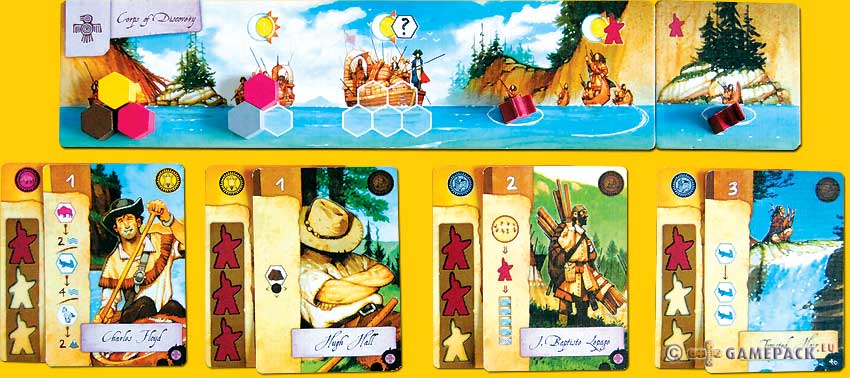 |
|
|
|
| x |
|
|
|
|
|
|
|
|
|
|
|
|
|
|
|
|
|
|
|
|
|
|
|
|
|
|
|
|
|
|
|
|
|
|
|
|
|
|
|
|
|
|
|
|
|
|
|
|
|
|
|
|
|
|
|
|
|
|
|
|
|
| Each turn a player must either play a card from his hand, or place an Indian next to an action in the Indian village. The played card shows what it yields: raw materials, converting materials, move the scout, or add all Indians in the village to the expedition. After playing a resource card, a player will check if the same resource symbol is on an already played card from his left or right player; these may be added to the played symbol and earn additional resources. |
|
|
|
|
| x |
|
|
|
|
|
|
|
|
|
|
|
|
|
|
|
|
|
|
|
|
|
|
|
|
|
|
|
|
|
|
|
|
|
|
|
|
|
|
|
|
|
|
|
|
|
|
|
|
|
|
|
|
|
|
|
|
|
|
|
|
|
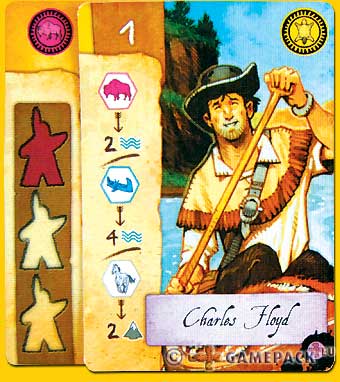 |
|
But playing a card is not just as easy as that: the card must either be supported by a second card from a player's hand, played with its reverse side that depicts from one to three Indians, or accompanied by one to three Indians, or a combination of both. The Indians are the factor the first card may be multiplied by, such as moving the scout two times when two Indians are involved. Or a player plays a card that allows taking wood, and plays a second card depicting two Indians; the player may take two wood. When the player on his left or right has an already played card that also depicts wood, he may take four wood -two Indians times two wood.
So even if a player may add Indians from his expedition to the played card the total of played Indians never may exceed three. The played cards remain on the table, forming a nice perk for the other players who in their turn may make use of the depicted symbols. |
|
|
|
|
| x |
|
|
|
|
|
|
|
|
|
|
|
|
|
|
|
|
|
|
|
|
|
|
|
|
|
|
|
|
|
|
|
|
|
|
|
|
|
|
|
|
|
|
|
|
|
|
|
|
|
|
|
|
|
|
|
|
|
|
|
|
|
| In the Indian village, dependant of the action, one or more Indians can be placed to receive resources, or trade these in for canoes or horses. |
|
|
|
|
| x |
|
|
|
|
|
|
|
|
|
|
|
|
|
|
|
|
|
|
|
|
|
|
|
|
|
|
|
|
|
|
|
|
|
|
|
|
|
|
|
|
|
|
|
|
|
|
|
|
|
|
|
|
|
|
|
|
|
|
|
|
|
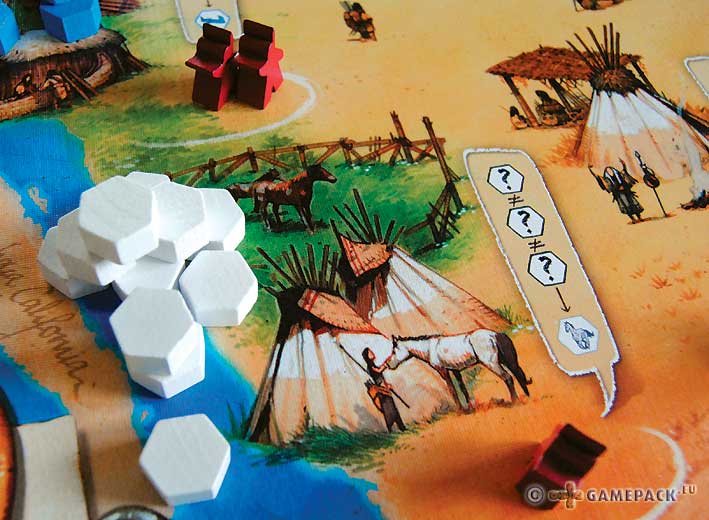 |
|
|
|
| x |
|
|
|
|
|
|
|
|
|
|
|
|
|
|
|
|
|
|
|
|
|
|
|
|
|
|
|
|
|
|
|
|
|
|
|
|
|
|
|
|
|
|
|
|
|
|
|
|
|
|
|
|
|
|
|
|
|
|
|
|
|
| In addition to the mandatory action of playing a card a player may buy a new character card; the costs for these decrease but always involve a certain amount of fur and equipmnt. The card is taken on the hand and can be played in a later turn. |
|
|
|
|
| x |
|
|
|
|
|
|
|
|
|
|
|
|
|
|
|
|
|
|
|
|
|
|
|
|
|
|
|
|
|
|
|
|
|
|
|
|
|
|
|
|
|
|
|
|
|
|
|
|
|
|
|
|
|
|
|
|
|
|
|
|
|
 |
|
|
|
| x |
|
|
|
|
|
|
|
|
|
|
|
|
|
|
|
|
|
|
|
|
|
|
|
|
|
|
|
|
|
|
|
|
|
|
|
|
|
|
|
|
|
|
|
|
|
|
|
|
|
|
|
|
|
|
|
|
|
|
|
|
|
| The action where it's all about, is setting up the camp. A player can do this anytime during his turn, before or after his mandatory action of playing a card. First is checked if the scout did not move too far ahead as there is a penalty of one space for each card a player still has in his hand, and the amount of resources and Indians in the boats can slow down the scout also. |
|
|
|
|
| x |
|
|
|
|
|
|
|
|
|
|
|
|
|
|
|
|
|
|
|
|
|
|
|
|
|
|
|
|
|
|
|
|
|
|
|
|
|
|
|
|
|
|
|
|
|
|
|
|
|
|
|
|
|
|
|
|
|
|
|
|
|
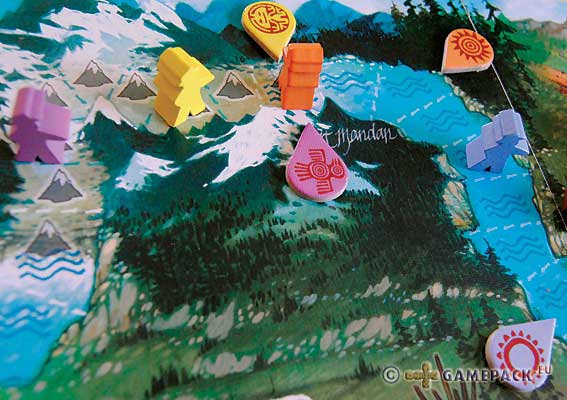 |
|
The scout then has to be put back the required amount of spaces, after which a player can set up his camp at the current position of the scout. Subsequently the player may take all played cards back to his hand. |
|
|
|
|
| x |
|
|
|
|
|
|
|
|
|
|
|
|
|
|
|
|
|
|
|
|
|
|
|
|
|
|
|
|
|
|
|
|
|
|
|
|
|
|
|
|
|
|
|
|
|
|
|
|
|
|
|
|
|
|
|
|
|
|
|
|
|
During the game players do not have the same rhythm as one player may have bought an additional character card allowing him to play an extra turn, while another player may decide to set up camp early, despite having one or more cards to play in his hand. Knowing which player still has the interpreter card in his hand can be of interest when wanting to collect all the Indians in the village; a player does not want to be too late, so to say arriving in a totally deserted Indian village when an other player before him has taken that action already. The Indians in the expedition supply a player with extra turns and these can be put to action to move the scout.
The played symbols at the left and right player can give the resource production a nice boost ; it would be a pity when such a player would decide to set up camp, thereby taking all his cards from the table. Knowing when a player will set up his camp therefore is not without interest; it would be a pity when a planned action is prevented or at least minimized by a player who decides to set up camp, thereby taking all his cards on his hand.
Copying an already played card is a popular action too that can be done by placing an Indian in the village at the designated spot, paying the action with one food. |
|
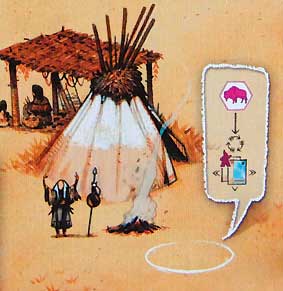 |
|
|
|
|
| x |
|
|
|
|
|
|
|
|
|
|
|
|
|
|
|
|
|
|
|
|
|
|
|
|
|
|
|
|
|
|
|
|
|
|
|
|
|
|
|
|
|
|
|
|
|
|
|
|
|
|
|
|
|
|
|
|
|
|
|
|
|
| So it goes forward in fits and starts. Canoes are used on the river, horses in the mountains. There is silent counting: will I be able to reach the mountains and be able to set up camp there, or do I suffer a penalty and does my scout have to move backwards? Eventually a player manages to bridge the last gap to or beyond Fort Clatsop, and usually also is the winner, leaving other players still trapped in their unfinished win formula. As it is a big puzzle, to reach the right location each time! |
|
|
|
|
| x |
|
|
|
|
|
|
|
|
|
|
|
|
|
|
|
|
|
|
|
|
|
|
|
|
|
|
|
|
|
|
|
|
|
|
|
|
|
|
|
|
|
|
|
|
|
|
|
|
|
|
|
|
|
|
|
|
|
|
|
|
|
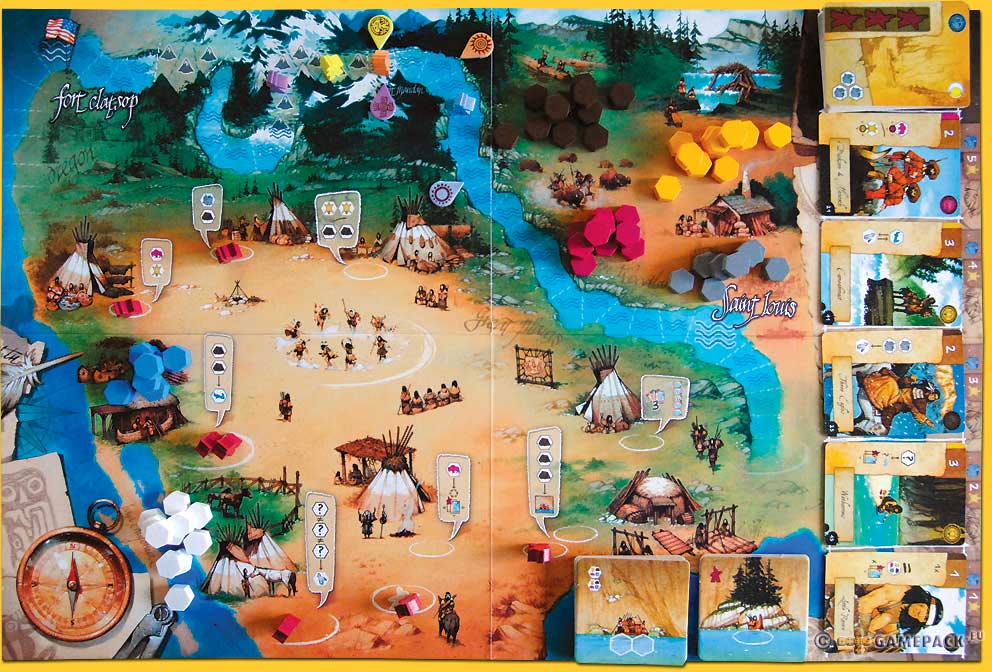 |
|
|
| x |
|
|
| x |
|
|
| x |
|
|
 |
|
|
|
|
|
|
|
|
|
|
|
|
|
|
|
|
|
|
|
|
|
|
|
|
|
|
|
|
|
|
|
|
|
|
|
|
|
|
|
|
|
|
|
|
|
|
|
|
|
|
|
|
| Lewis & Clark stands out by its different game mechanism, but it is different and yet familiar at the same time. Placing workers, play cards; these are familiar actions seen in many other games. But Lewis & clark also has some logistics, determined by the penalties from the hand cards and the loads and the Indians on the ships. Collecting many Indians from the village may be advantageous, but when these are located in boats wit a penalty when setting up camp, the Indians turn into an unwanted burden. Additional can be bought to avoid or reduce this time penalty, but again this is a consideration to make, as the needed resources for these boats could be brought to better use elsewhere. |
|
|
|
|
| x |
|
|
|
|
|
|
|
|
|
|
|
|
|
|
|
|
|
|
|
|
|
|
|
|
|
|
|
|
|
|
|
|
|
|
|
|
|
|
|
|
|
|
|
|
|
|
|
|
|
|
|
|
|
|
|
|
|
|
|
|
|
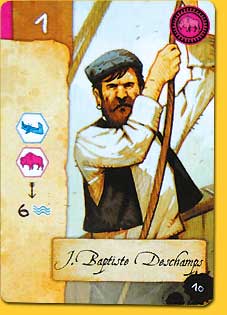 |
There are many useful character cards in the deck that can be bought. Waiting for a card to shift to the right and becoming cheaper might turn out to be a risky decision, as when a player plays the card with which he collects all the Indians in the village, the cheapest card in the display also is removed. Besides, an other player might want the specific card too, buying it in his turn, leaving one whistling for it. Keeping an eye on an other player's resources is another good thing to do as knowing if a player actually is able to buy that specific card removes a lot of the pressure.
Having a lot of character cards allows a player to perform lots of actions; yet these cards also can be a burden when a player's hand of cards becomes too large and the already played action can only be done again when the camp has been set up and all cards taken back to the hand. To expedite this choice, there is a special action in the Indian village where a player may discard from one to three cards from his hand. |
|
|
|
|
| x |
|
|
|
|
|
|
|
|
|
|
|
|
|
|
|
|
|
|
|
|
|
|
|
|
|
|
|
|
|
|
|
|
|
|
|
|
|
|
|
|
|
|
|
|
|
|
|
|
|
|
|
|
|
|
|
|
|
|
|
|
|
| The game feels very fresh, and it's a fun puzzle to maximize the scout's movement with all the cards and Indians, and try to set camp at the most favorable position. The game by no means does take long to play, and usually it is a sudden dénouement when a player all of a sudden manages to bridge the last spaces, and without or without too many penalties sets up camp at or beyond Fort Clatsop, while the rest of the players were still pondering over their next move. |
|
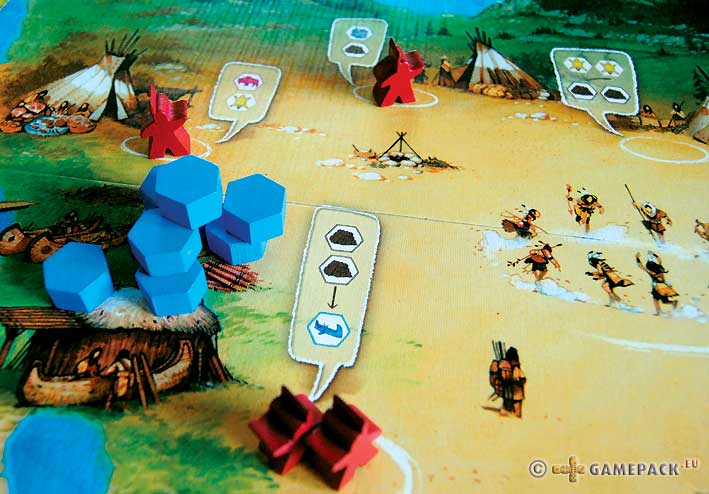 |
|
|
|
| x |
|
|
|
|
|
|
|
|
|
|
|
|
|
|
|
|
|
|
|
|
|
|
|
|
|
|
|
|
|
|
|
|
|
|
|
|
|
|
|
|
|
|
|
|
|
|
|
|
|
|
|
|
|
|
|
|
|
|
|
|
|
Lewis & Clark: distinctive, beautifully illustrated, well executed, and a pleasure to play.
© 2014 Richard van Vugt
Lewis & Clark, Cédrick Chaboussit, Ludonaute / Asmodee, 2013 - 1 to 5 players, 14 years and up, 30 minutes per player
|
|
|
  |
|
|
|
|
|
|
|
|
|
|
|
|
|
|
|
|
|
|
|
|
|
|
|
|
|
|
|
|
|
|
|
|
|
|
|
|
|
|
|
|
|
|
|
|
|
|
|
|
|
|
|
|
  |
|
|
|
|
|
|
|
|
|
|
|
|
|
|
|
|
|
|
|
|
|
|
|
|
|
|
|
|
|
|
|
|
|
|
|
|
|
|
|
|
|
|
|
|
|
|
|
|
|
|
|
|
  |
|
|
|
|
|
|
|
|
|
|
|
|
|
|
|
|
|
|
|
|
|
|
|
|
|
|
|
|
|
|
|
|
|
|
|
|
|
|
|
|
|
|
|
|
|
|
|
|
|
|
|
|
  |
|
|
|
|
|
|
|
|
|
|
|
|
|
|
|
|
|
|
|
|
|
|
|
|
|
|
|
|
|
|
|
|
|
|
|
|
|
|
|
|
|
|
|
|
|
|
|
|
|
|
|
|
| x |
|
|
|
|
|
|
|
|
|
|
|
|
|
|
|
|
|
|
|
|
|
|
|
|
|
|
|
|
|
|
|
|
|
|
|
|
|
|
|
|
|
|
|
|
|
|
|
|
|
|
|
|
|
|
|
|
|
|
|
|
|
| x |
|
|
|
|
|
|
|
|
|
|
|
|
|
|
|
|
|
|
|
|
|
|
|
|
|
|
|
|
|
|
|
|
|
|
|
|
|
|
|
|
|
|
|
|
|
|
|
|
|
|
|
|
|
|
|
|
|
|
|
|
|
 |
|
|
|
|
|
|
|
|
|
|
|
|
|
|
|
|
|
|
|
|
|
|
|
|
|
|
|
|
|
|
|
|
|
|
|
|
|
|
|
|
|
|
|
|
|
|
|
|
|
|
|
|
 |
|
|
|
|
|
|
|
|
|
|
|
|
|
|
|
|
|
|
|
|
|
|
|
|
|
|
|
|
|
|
|
|
|
|
|
|
|
|
|
|
|
|
|
|
|
|
|
|
|
|
|
|
| x |
|
|
|
|
|
|
|
|
|
|
|
|
|
|
|
|
|
|
|
|
|
|
|
|
|
|
|
|
|
|
|
|
|
|
|
|
|
|
|
|
|
|
|
|
|
|
|
|
|
|
|
|
|
|
|
|
|
|
|
|
|
 |
|
|
|
|
|
|
|
|
|
|
|
|
|
|
|
|
|
|
|
|
|
|
|
|
|
|
|
|
|
|
|
|
|
|
|
|
|
|
|
|
|
|
 |
|
|
|
|
|
|
|
|
|
|
|
|
|
|
|
|
|
|
|
|
|
|
|
|
|
|
|
|
|
|
|
|
|
|
|
|
|
|
|
|
|
|
|
|